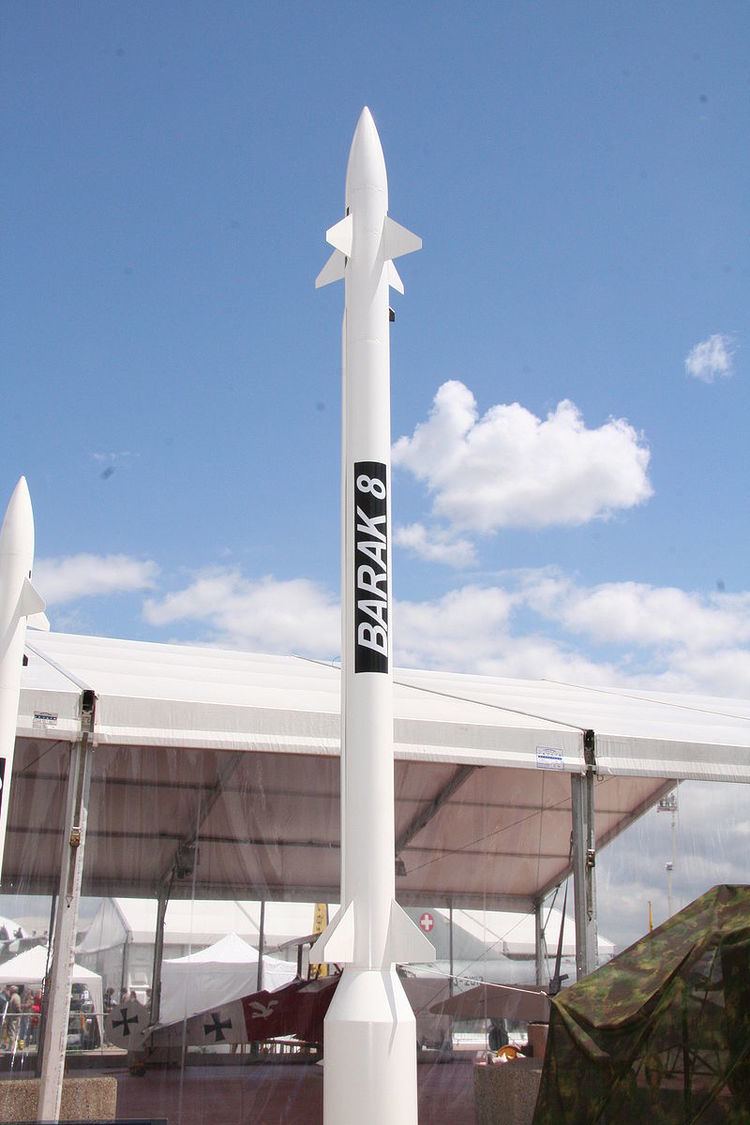In service Induction Phase | ||
 | ||
Used by Indian NavyIndian Air ForceIsraeli Navy Designer Israel Aerospace IndustriesDefence Research and Development Organisation Manufacturer Rafael Advanced Defense SystemsBharat Dynamics Limited | ||
Barak 8 (the Hebrew word for Lightning) also known as LR-SAM or as MR-SAM is an Indian-Israeli surface-to-air missile (SAM), designed to defend against any type of airborne threat including aircraft, helicopters, anti-ship missiles, and UAVs as well as cruise missiles and combat jets out to a maximum range of 70 km, however, reports suggest the missile has been increased to a maximum range of 90 km following "range upgrade discussions" between India and Israel during November 2014. Some news agencies have referred to the missiles range at 100 km. Both maritime and land-based versions of the system exist.
Contents
Barak 8 was jointly developed by Israel Aerospace Industries (IAI), India's Defence Research & Development Organisation (DRDO), Israel's Administration for the Development of Weapons and Technological Infrastructure, Elta Systems, Rafael and other companies. Bharat Dynamics Limited (BDL) will produce the missiles.
Background
Barak 8 is based on the original Barak 1 missile and is expected to feature a more advanced seeker, alongside range extensions that will move it closer to medium range naval systems like the RIM-162 ESSM or even the SM-2 Standard. Israel successfully tested its improved Barak II missile on July 30, 2009. The radar system provides 360 degree coverage and the missiles can take down an incoming missile as close as 500 meters away from the ship. Each Barak system (missile container, radar, computers and installation) costs about $24 million. In November 2009 Israel signed a $1.1 billion contract to supply an upgraded tactical Barak 8 air defence system to India.
On 3 December 2016, Indian Minister of State for Defence Subhash Bhamre informed the Lok Sabha that successful trials of the missile had been completed, and that the weapon systems were proven end-to-end. Bhamre also told the House that delivery of Barak 8 missiles to Indian Navy had already commenced.
The Israeli Navy has commenced equipping its Sa'ar 5 corvettes with the system, the first re-fitted vessel being the INS Lahav. The Sa'ar 4.5 flotilla will be next for the upgrade. The first 32 missile array will be fitted on the Indian Navy stealth guided-missile destroyer INS Kolkata (D63).
Design
The Barak 8 has a length of about 4.5 meters, a diameter of 0.225 meters at missile body, and 0.54 meters at the booster stage, a wingspan of 0.94 meters and weighs 275 kg including a 60 kg warhead which detonates at proximity. The missile has maximum speed of Mach 2 with a maximum operational range of 70 km, which was later increased to 100 km. Barak 8 features a dual pulse rocket motor as well as Thrust vector control, and possesses high degrees of maneuverability at target interception range. A second motor is fired during the terminal phase, at which stage the active radar seeker is activated to home in on to the enemy track. Barak 8 has been designed to counter a wide variety of air-borne threats, such as; anti-ship missiles, aircraft, UAVs drones and supersonic missiles When coupled with a modern air-defence system and multi-function surveillance track and guidance radars, (such as the EL/M-2248 MF-STAR AESA on board the Kolkata-class destroyers) Barak 8 enables the capability to simultaneously engage multiple targets during saturation attacks.
Israel Aerospace Industries describe Barak 8 as "an advanced, long-range missile defense and air defense system" with its main features being:
Barak 8 has been described as giving potential use as a point defence anti-ballistic missile due to its combination of advanced capabilities.
MR-SAM
MR-SAM is the land based configuration of the missile. It consists of a command and control system, tracking radar, missile and mobile launcher systems. Each launcher will have eight such missiles in two stacks and are launched in a canister configuration. The system is also fitted with an advanced radio frequency (RF) seeker.
The Indian Army ordered five regiments of this version, which consists of about 40 launchers and 200 missiles for ₹17,000 crore (US$2.5 billion). It is expected to be deployed by 2023.
Barak-8ER
It has been reported that an ER (extended range) variant of the Barak 8 is under development, which will see the missiles maximum range increased to 150 km. Designed to engage multiple beyond visual range threats, the low launch signature Barak-8ER is understood to retain the same autopilot/inertial navigation system and active radar seeker guidance as the Barak-8, although some modifications to the software and to the missile control surfaces are likely. The booster increases the length of the missile at launch from its current 4.5 m to nearly 6 m, although the length in flight after the booster has been jettisoned may be slightly less than the base Barak-8 missile, if a TVC is not present. The missile diameter and fin spans are thought to be the same as the base Barak-8. The booster weight is currently unknown, although the missile's weight after the booster has been jettisoned is the same as that for the current Barak-8 configuration.
Levy said that initial operational capability (IOC) for Barak-8ER will first be declared for the naval variant, followed by IOC for the land variant. He declined to comment on a launch customer for Barak-8ER, but noted "existing Barak-8 customers will be interested in this configuration because it offers additional capability to their current system". The missile is expected to equip the Indian Navys future Visakhapatnam-class destroyers.
